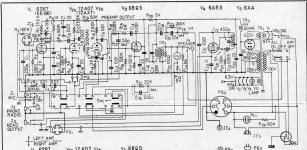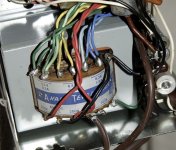I was trying to convert an old Akai M7 reel-to-reel into stand alone amps. My DIY experience was pretty limited. When attaching the new power cords to the transformer taps, I screwed up and had one amp with the leads at the 110v tap and the other at the 117v tap ( the amps was wired a little different from each other and I didn't notice) I thought I had one lead on the common tap. Something on the underside shorted, I quickly turned the power off.
Now I need help figuring out the damage, Looking at the schematic, knowing what I did, can someone suggest where to begin looking. I have the one amp working and think I should be able to swap out suspect components with ones from my good amp.
-Brad
Akai M7 Left Schematic.jpg
Now I need help figuring out the damage, Looking at the schematic, knowing what I did, can someone suggest where to begin looking. I have the one amp working and think I should be able to swap out suspect components with ones from my good amp.
-Brad
Akai M7 Left Schematic.jpg
Attachments
Putting 120Vrms across a winding that's expecting 7.0V probably poofed the power xfmr.
That's why it's always a good idea to power up for the first time with a Variac, or at least a light bulb in series with the AC mains connection. You can catch just such errors before you poof something.
That's why it's always a good idea to power up for the first time with a Variac, or at least a light bulb in series with the AC mains connection. You can catch just such errors before you poof something.
Hi,
If you are sure that every thing is OK. Please be carefull of stored charge! Never pull tubes or replace with power on!
Remove the rectifier tube set your test meter to AC volts.
Power on.
Test incomming supply, heater supply and High tension supply only the AC will be on B+ "should" be dead. Heaters should come on!
Power off.
Let us know what you get! Only power up as long as necessary for tests. Always test for stored charge before touching.
Regards
M. Gregg
If you are sure that every thing is OK. Please be carefull of stored charge! Never pull tubes or replace with power on!
Remove the rectifier tube set your test meter to AC volts.
Power on.
Test incomming supply, heater supply and High tension supply only the AC will be on B+ "should" be dead. Heaters should come on!
Power off.
Let us know what you get! Only power up as long as necessary for tests. Always test for stored charge before touching.
Regards
M. Gregg
Last edited:
As Miles said. That why fuses are used. If it wasn't fused, and the wiring external to the power transformer is intact, you almost certainly fried at least the 117V tap. And you probably damaged the internal insulation of the transformer. You can check by measuring the resistance between the 0 and 117V taps. I suspect it will be open. Don't power anything up until you have a working power transformer.
Sheldon
Sheldon
With any luck he blew a fuse, if not the 110-117v will be open and the 0-110v will be OK. Otherwise it's a new Tx.
Regards
M. Gregg
Regards
M. Gregg
I don't have any open readings!
I'm really just learning and I spent a decent amount of time just trying to figure out terminology. Is the heater supply the cropped schematic I've attached and the blue wires attached to the 6.3V 1.8A taps?
I not sure what/where the high tension supply is.
Is the "rectifier tube set" the power tube in this case the 6BQ5?
There were no fuses, I will put some in now.
I sure have a lot to learn.
-Brad
_DSC4553.jpg
heater.jpg
I'm really just learning and I spent a decent amount of time just trying to figure out terminology. Is the heater supply the cropped schematic I've attached and the blue wires attached to the 6.3V 1.8A taps?
I not sure what/where the high tension supply is.
Is the "rectifier tube set" the power tube in this case the 6BQ5?
There were no fuses, I will put some in now.
I sure have a lot to learn.
-Brad
_DSC4553.jpg
heater.jpg
Attachments
I would think that the 110-117 tap (which would be wound as part of the 0-110 winding) would have the insulation fried which would probably have damaged the 0-110 winding. But let's hope for the best.
xbartx,
I guess you are not sure what to do!
Just a quick check with power off do a resistance check from 0 to 110v connection and a test from 0 to 117v connection tell us what you get!
Do you have a multi-meter?
Regards
M. Gregg
I guess you are not sure what to do!
Just a quick check with power off do a resistance check from 0 to 110v connection and a test from 0 to 117v connection tell us what you get!
Do you have a multi-meter?
Regards
M. Gregg
Last edited:
The rectifier is the 6x4
yes the cropped pic is the heater.
Lets keep the tests with power off
It is hard to see from the pic where is the mains connection is it behind the red wire?
The high tension is the high voltage B+
yes the cropped pic is the heater.
Lets keep the tests with power off
It is hard to see from the pic where is the mains connection is it behind the red wire?
The high tension is the high voltage B+
Last edited:
XbartX,
I need to ask please don't take this personal how old are you?
Have you read the safety section in the sticky thread?
Regards
M. Gregg
I need to ask please don't take this personal how old are you?
Have you read the safety section in the sticky thread?
Regards
M. Gregg
Last edited:
xbartx,
I guess you are not sure what to do!
Just a quick check with power off do a resistance check from 0 to 110v connection and a test from 0 to 117v connection tell us what you get!
Do you have a multi-meter?
Regards
M. Gregg
Yes, I have a multi-meter. I tested the resistance, I set the multi meter on the ohm section and in both the 0 to 110v connection and 0 to 117v connection, It doesn't show as open (the needle on my meter moves all the way to 0 ohms).
I'm over 50, I will try to be safe.
-Brad
OK,
Please take care I think you need some one to assist you in person.
These voltages can kill!
Kind regards
M. Gregg
Please take care I think you need some one to assist you in person.
These voltages can kill!
Kind regards
M. Gregg
XbartX,
Have you read the safety section in the sticky thread?
Regards
M. Gregg
Maybe I should put this project aside for a while, build up my electronics knowledge some and get back to it at a later time. My electronics audio experience is limited working on a few vintage speakers and replacing a few pre-stuffed boards on a Dynaco amp. I did enjoy the projects and hope to learn more. Maybe starting with a kit of some kind?
I do appreciate the help.
-Brad
Maybe I should put this project aside for a while, build up my electronics knowledge some and get back to it at a later time. My electronics audio experience is limited working on a few vintage speakers and replacing a few pre-stuffed boards on a Dynaco amp. I did enjoy the projects and hope to learn more. Maybe starting with a kit of some kind?
I do appreciate the help.
-Brad
I think a kit is a good place to start. We all started at some point, however I am thinking of your safety.🙂
After a kit build you will see this project in a different light. You can get a lot out of this hobby. I do wish you all the best but as you say start with a project and you will learn alot. Safety has to be the most important point! I am sure every one would help you with a known circuit. It is very easy to get caught out with older equipment!😉
Regards
M. Gregg
- Status
- Not open for further replies.
- Home
- Amplifiers
- Tubes / Valves
- Any thoughts on what damage I did?


